The VAEEC has been focused on advancing Commercial Property Assessed Clean Energy, or C-PACE, financing across the Commonwealth for the past few years. Since Virginia’s C-PACE law requires interested localities to develop and implement their own C-PACE program, start up can be on the slow side. However, we’ve seen a lot more traction lately thanks in part to the launch of Virginia’s first C-PACE program (in Arlington County) and the recent release of C-PACE resources for local governments.
Program Status in Virginia
Over 30 states and Washington, D.C. have approved C-PACE programs. Virginia joined this growing list in 2009 when it first passed C-PACE enabling legislation, which was later amended in 2015. Our C-PACE law includes all new and existing commercial, industrial, multifamily residential (over four units), and nonprofit buildings.
Arlington County’s C-PACE program officially launched in January of this year with the goal of improving new and existing buildings and helping the County’s Community Energy Plan implementation. Sustainable Real Estate Solutions, or SRS, was selected as their independent, third party program administrator to provide marketing, outreach, education, and quality assurance services.
During a January 2018 Board meeting, the Loudoun County Board of Supervisors unanimously voted to direct staff to develop a C-PACE program structure, evaluate options for Program Administration, and draft an ordinance. These items will be brought back to the Board at a future meeting for consideration. Similarly, Fairfax County is exploring the development of a C-PACE program. County staff are developing information for the Environmental Committee with the goal of presenting their findings to the Committee at their next meeting on June 12th.
In addition to providing educational information to Loudoun and Fairfax, the VAEEC is working with several other jurisdictions to answer questions and help with program development. Just last week, we worked with the City of Virginia Beach to organize a C-PACE informational session for all municipal staff in the Hampton Roads region. Representatives from the Cities of Norfolk, Portsmouth, and Virginia Beach were in attendance. We are also working with local Virginia chapters of the Sierra Club to host a C-PACE event on May 30th in the City of Alexandria. This event will be open to all C-PACE stakeholders in the area, including property owners, contractors, lenders, and municipal staff. We also continue to work with the City of Charlottesville and Albemarle County to answer staff questions and provide guidance on the resources currently available to localities.
Resources for Local Governments
In early 2018, the VAEEC released a Virginia model ordinance for localities to use when crafting their own program. The ordinance was commissioned following a review and input from a wide variety of C-PACE experts in the lending, local government, engineering, legal, and policy fields. This document incorporated key factors that we consider to be crucial to implementing an effective C-PACE program.
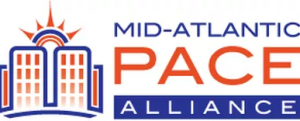
Accelerating C-PACE throughout DC, MD, & VA
As part of its mission to accelerate the development and utilization of C-PACE in the Mid-Atlantic region, MAPA is currently creating program implementation guidance. These regional guidelines will be a part of a toolkit created to help localities craft their own C-PACE program and is slated to be released by June. In conjunction with MAPA, the VAEEC will be hosting a C-PACE webinar in September that will walk attendees through both this toolkit and the Virginia model ordinance.
Virginia localities may review the program infrastructure implemented in Arlington County, including the County ordinance and other program documents. There is also the option to “ride” the C-PACE Program Administration contract with SRS, which would eliminate the need for a Request for Proposals (RFP) process and shortens the time to program launch. Localities may also contract directly with SRS if cooperative procurement is not preferred. Explore the Arlington C-PACE website for more information.
The VAEEC prides itself on being a neutral, trusted resource for any Virginia localities interested in C-PACE. We are actively meeting with local governments across Virginia to discuss all available options and help each locality determine which option best suits their needs. If you would like to know more about C-PACE, contact Jessica Greene at jessica@vaeec.org.
The public hearings for the Carbon Trading Rule and Clean Energy Virginia Initiative have wrapped up, but there is still time to submit public comments before the April 9th deadline. VAEEC encourages members to submit comments supporting the energy efficiency carve out and are happy to help you draft comments.
VAEEC Comments
Click here to view VAEEC’s public comments.
Background
Last November, the Virginia Air Pollution Control Board approved Governor McAuliffe’s regulations to limit carbon emissions from Virginia’s electric generating facilities. These regulations will:
- cap emissions at 33 or 34 million tons
- reduce carbon emissions 30% between 2020-2030
The state will hold quarterly consignment auctions to determine the cost of the allowances and the money from that auction will be given back to the utilities (not to state), which is a first of its kind in the US.
Five percent of the allowances will be withheld from the consignment auction and will be transferred to the Department of Mines, Minerals and Energy (DMME) to implement energy efficiency programs. DMME plans to hold a separate rulemaking for this piece of the carbon rule later this year. VAEEC will continue providing resources to DMME as they investigate options for program design and implementation.
There is currently an open comment period through April 9th, 2018.
Passage of the Grid Transformation and Security Act of 2018 underscores the widespread, bipartisan agreement that energy efficiency is a smart investment for the Commonwealth. The VAEEC endorsed this legislation because of the tremendous potential opportunities for energy-saving programs that will be provided to Virginians over the next decade, including a combined commitment by the electric utilities to spend over $1.3 billion on energy efficiency programs. Unfortunately, all of that potential could easily evaporate away.
Last month, the State Corporation Commission (SCC) held proceedings to review proposed energy efficiency programs for both Appalachian Power Company (APCO) and Dominion Energy. Dominion Energy filed for approval to extend their low-income program for another five years. As defined by Virginia law, low-income programs are already determined to be in the public interest so these types of programs do not face as much scrutiny by the SCC.
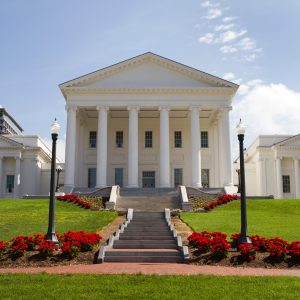 During the APCO proceeding however, the SCC staff recommended rejecting all five of the utility’s proposed residential programs. For three of these programs, the SCC staff stated that the utility had not taken into account new federal lighting standards taking effect in 2020. APCO decided to withdraw one of the programs for consideration due to this change but argued in their rebuttal testimony that the SCC staff’s interpretation of the new standard was incorrect for the other two programs since they would be direct install measures. Meaning, the program contractors would directly install the new LED light bulbs into sockets where incandescent light bulbs currently exist and would not be replacing CFL light bulbs with LEDs, as stated in the SCC staff response.
During the APCO proceeding however, the SCC staff recommended rejecting all five of the utility’s proposed residential programs. For three of these programs, the SCC staff stated that the utility had not taken into account new federal lighting standards taking effect in 2020. APCO decided to withdraw one of the programs for consideration due to this change but argued in their rebuttal testimony that the SCC staff’s interpretation of the new standard was incorrect for the other two programs since they would be direct install measures. Meaning, the program contractors would directly install the new LED light bulbs into sockets where incandescent light bulbs currently exist and would not be replacing CFL light bulbs with LEDs, as stated in the SCC staff response.
Similarly concerning was the SCC staff’s re-calculation of the cost-benefit tests for APCO’s appliance recycling program renewal, which incentivizes customers in their territory to recycle secondary appliances such as refrigerators. The SCC staff stated that the company miscalculated the cost-benefit tests of this program and performed new calculations, causing the program to fail two of the four cost-benefit tests.
According to experts I’ve spoken with, these new test results calculated by the SCC staff for the appliance recycling program are questionable since there is no customer cost for this particular program, therefore, it is unclear how this program could fail the Total Resource Cost Test but not the Utility Cost Test. Below is a table that was produced in a 2014 VAEEC report explaining the purpose of all four tests.
You may be wondering what this means, especially since this is all pretty technical, but what it boils down to is this: the substantial commitments to energy efficiency by both Dominion Energy and Appalachian Power Company in the omnibus utility bill will not come to fruition if energy efficiency programs continue to be scrutinized in this manner.
To be clear, the VAEEC supports the role that the SCC plays in scrutinizing proposals put forth by the utilities. That is their job and it is an important one. However, they tend to scrutinize energy efficiency programs more so than other proposals- including new power generating facilities. They do not view energy efficiency as a true resource when it comes to planning for future energy needs, when, in fact, it should be viewed as the critical first step. The kilowatt that goes unused is the cheapest form of energy. Allowing utilities to develop robust programs that help all customers make smart energy choices helps reduce the need for new, larger power generation facilities in the future. Energy efficiency isn’t a silver bullet by any means, but it is a valuable tool in the toolbox that should be utilized much more often than it is now.
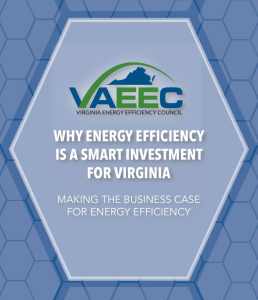
Investments in energy efficiency also mean new jobs in every corner of Virginia. In our report “Why Energy Efficiency is a Smart investment for Virginia,” we found that energy efficiency is a $1.5 billion industry in Virginia that supports approximately 75,000 jobs. Greater investments and growth in energy efficiency means more jobs in the local communities being served- jobs that cannot be outsourced out-of-state or overseas. This is the argument that we have made before the SCC over the last two years.
The SCC should evaluate the economic development and job creating benefits that these programs create in the local communities they serve. These same benefits are included in the analysis to build new fossil-fueled facilities, so why wouldn’t the same economic benefits for energy efficiency be factored in as well? Especially given that most of the jobs created by building new power plants are temporary construction jobs whereas the jobs provided by energy efficiency programs are year-round and last for the life cycle of program.
The vacant seat on the SCC provides a unique opportunity to unleash the economic potential of energy efficiency for the citizens of the Commonwealth. It is our hope that a new Commissioner is appointed soon and that he or she sees the value and tremendous opportunity that energy efficiency provides. Otherwise, we will be leaving over a billion dollars on the table.
As an all-female staff, every month is women’s month for the VAEEC. However, as March comes to a close we want to honor Women’s Month and highlight some of our formidable female leaders on our board. The VAEEC board consists of 14 people including three women: Cynthia Adams, Lesley Fore and Carla Dix. Each of the women on our board offer experience and expertise in leadership, management and technological innovation within the energy efficiency sector. Cynthia Adams is the former chair of the Virginia Energy Efficiency Council and current CEO of Pearl Certification, a company that certifies energy efficiency in homes. Carla Dix is Lead Performance Analyst for Warm Wise, Columbia Gas of Virginia’s energy efficiency program. Lesley Fore is the Executive Director of the Local Energy Alliance Program (LEAP) and is one of our newest Board members.
We asked them about what it means to be a female-leader in the energy efficiency sector and why gender diversity is important for our sector to be fully successful. Their responses show varying approaches to the energy efficiency field and offer insight to the challenges of diversifying, how technology has changed since they began their work, as well as advice for women as they advance in the energy efficiency field.
How has the energy efficiency sector diversified since you began working in it and what challenges remain?
Cynthia: My entre into the energy efficiency industry came via my work as a green builder fifteen years ago, and there certainly weren’t many women involved in construction then. The sector has diversified some since I first started, but we have a long way to go. As more women get degrees in engineering and architecture, the number of women in energy efficiency has increased. Some women become supporters of the industry through other professional channels, such as journalism and markeing, which is great. The better we get at talking about the benefits of energy efficiency, the more uptake we can expect to see. I’ll note that when the VAEEC first launched, I was the only woman on the Governance Board. We’ve made good strides since then. Pay equity is yet a challenge; it’s been well-documented through multiple sources that young women in STEM fields earn about a third less than their male counterparts.
Carla: There have been some great new technologies since I began working in the energy efficiency sector. Smart thermostats, for example. These have advanced features, such as occupancy sensors, learning capabilities, and even give users the ability to control their thermostat using a smartphone. Columbia Gas of Virginia received approval to offer smart thermostat rebates in Phase 3 of our energy efficiency program and reached the 3-year participation goal within the 1st year!
A challenge that remains is the ability to engage small business customers to participate in utility energy efficiency program offerings. It has been difficult to reach the decision makers of these businesses to educate them on the value of energy efficiency.
Lesley: I joined the energy efficiency sector in 2010 working for LEAP. While, like most job sectors, there were more men than women, I was pleasantly surprised that there were plenty of women working in this space, though mostly on the less technical side.
As far as challenges, I’ve been aware of a substantive difference in what the men were paid as compared to with similar job responsibilities and titles. At times, I’ve seen women out-performing their male colleagues, but not being equally compensated. Pay discrepancy remains a problem to this day, unfortunately. Another challenge I see in this industry is the lack of African Americans and Hispanics in programmatic or leadership positions. Energy efficiency is a topic that affects us all, no matter race, gender, or background. It would be ideal to see a more diverse cross-section of individuals in this sector representing not only their companies, but also their own unique perspective.
Why does gender diversity in leadership matter?
Cynthia: Gender diversity in leadership matters for the same reasons that cultural and ethnic diversity matter – a team that has different backgrounds and perspectives is better equiped to provide unique and innovative solutions to problems. It’s important as well for our next generation of women to have strong role models to inspire and support their own educational and professional efforts.
Carla: Gender diversity in leadership is important because men and women have different viewpoints, experiences, and insights. Having individuals at the leadership level that possess a wide range of experiences allows for better problem solving, ultimately leading to enhanced business performance.
Lesley: When does gender diversity in leadership ever not matter? Remember the book Men are from Mars, Women are from Venus? Men and women think differently in some respects, and bring different capabilities to the table. Without one, the other is only half complete. As a society, we’re still addressing women’s issues that have existed for centuries, but progress is definitely happening, and working your way up to a leadership position is an example of how that progress is happening.
Is there any advice you can give to women who want to advance as leaders?
Cynthia: All good leaders have good mentors, so my first piece of advice is to find a good mentor. That said, seek out a woman mentor in particular. She’ll be able to give you frank and important advice that speaks to specific challenges women in the workplace must overcome.
Carla: Get involved – take advantage of opportunities for learning, networking, and building relationships with others.
Lesley: You’ll likely have to work twice as hard as your male counterparts. It’s the world we live in. And, ask for what you want. It is easier for men to be heard for the very simple reason that their voices are often deeper and carry further. Even today, in 2018, some women are less likely to express an open in a room filled with men, who seem so comfortable with engaging and sharing their thoughts. You don’t need to be aggressive by any means; just make sure you’re heard. Don’t be discouraged when your input doesn’t seem to take hold. Try and try again.
What’s one thing women who are beginning work in the energy efficiency space should know?
Cynthia: In my experience, the energy efficiency industry isn’t markedly different from another technology industry with respect to gender. Yes, there are fewer women in it, but that doesn’t mean women can’t advance. The hardest thing women must work through from a career perspective is juggling family life with work – especially when children are very young. Preparing and planning for those years is so important when it comes to creating a fulfilling professional and personal life.
Carla: There are some very technical and complex topics you may be involved with – EM&V (evaluation, measurement and verification), cost-effectiveness tests, etc… but don’t be intimidated! It’s great to be involved in the energy efficiency industry.
Lesley: You’re entering a sector where a lot of very smart people have dedicated a lot of time and resources to cracking the nut to increase energy efficiency adoption. It’s proved difficult, but we are making a difference. At the end of the day, making that difference leads my passion to do this work, because we’re helping families, we’re helping businesses, and we’re helping the environment.
Carbon Rule/ Clean Energy Virginia Initiative
The open comment period and public hearings for the carbon rule and Clean Energy Virginia Initiative are still underway. VAEEC encourages members to submit comments supporting the energy efficiency carve out and are happy to help you draft comments. We also encourage members to attend the hearings listed below:
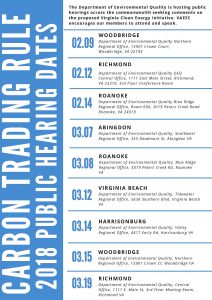
View in PDF.
Last November, the Virginia Air Pollution Control Board approved Governor McAuliffe’s regulations to limit carbon emissions from Virginia’s electric generating facilities. These regulations will:
- cap emissions at 33 or 34 million tons
- reduce carbon emissions 30% between 2020-2030
The state will hold quarterly consignment auctions to determine the cost of the allowances and the money from that auction will be given back to the utilities (not to state), which is a first of its kind in the US.
Five percent of the allowances will be withheld from the consignment auction and will be transferred to the Department of Mines, Minerals and Energy (DMME) to implement energy efficiency programs. DMME plans to hold a separate rulemaking for this piece of the carbon rule later this year. VAEEC will continue providing resources to DMME as they investigate options for program design and implementation.
There is currently an open comment period through April 9th, 2018 and public hearings taking place throughout the Commonwealth in early March on the Clean Energy Virginia Initiative.
 The Virginia Energy Efficiency Council is excited to announce a new member benefit: the VAEEC Membership Directory. This member-only tool is password protected and hosted on the VAEEC website.
The Virginia Energy Efficiency Council is excited to announce a new member benefit: the VAEEC Membership Directory. This member-only tool is password protected and hosted on the VAEEC website.
The directory expands networking opportunities among VAEEC members by allowing you to seek out other members with whom you share a common affiliation or interest. We are always looking for ways to improve communications with our members and are excited to provide this new and valuable service for you.
To be included, a member must provide appropriate directory contact information by emailing info@vaeec.org and membership dues must be fully paid. The directory will be updated monthly to included the latest submitted information.
To maintain access to the directory, members are asked to adhere to the VAEEC membership directory guidelines. Any member who feels that the directory is being misused should contact VAEEC staff through info@vaeec.org.
Members: The Membership Directory is accessible from the Member Resources page. When prompted, enter the password provided via email. If you cannot find the password, email info@vaeec.org.
Developed on behalf of the Energy Efficiency For All Project, the Vermont Energy Investment Corporation just released a report, Commercial PACE for Affordable Multifamily Housing, looking into the handful of affordable multifamily transactions that have used Commercial Property Assessed Clean Energy financing, or C-PACE.
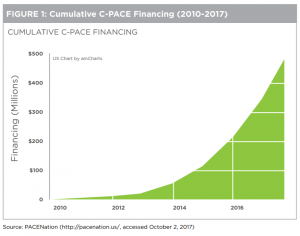
Growth of C-PACE in the US since 2010
In the past seven years, C-PACE financing has grown exponentially across the U.S. In fact, the latest numbers from PACENation show that there has been $521 million in C-PACE assessments funded through 1,157 projects. However, very few affordable multifamily housing stakeholders have taken advantage of this financing mechanism. Therefore, the purpose of this report was to explore whether or not C-PACE can be used to fill a financing gap for energy efficiency in the affordable multifamily buildings sector, and if so, to identify the best practices.
Several theories exist as to why C-PACE has not been commonly used in the affordable multifamily sector. However, the case for using C-PACE in affordable multifamily housing is strong:
- Tax assessment, not a loan
- Off balance sheet
- Based on owner’s equity rather than future income
- Structured to recoup savings to cover costs
- Potential to fill financing gaps
Through cataloging existing C-PACE programs that have either been used by or created for the affordable multifamily sector, the study revealed the following findings:
- There have been few C-PACE transactions within the affordable multifamily housing sector.
- Most of the completed transactions have had relatively simple financing structures.
- Thus far, only one C-PACE deal has been used on a U.S. Department of Housing and Urban Development (HUD) financed property, and only one deal used on an affordable, multifamily transaction using the Low-Income Housing Tax Credit (LIHTC).
- The differences in each state’s enabling legislation have not led to substantive differences for C-PACE program administrators. However, these variations at the local and state level could hinder the ability of capital across state borders.
- There could be difficulties using C-PACE on new construction due to the difficulty of determining the Savings to Investment Ratio (SIR).
Based on these findings, the authors were able to compile best practices and recommendations for using C-PACE with affordable multifamily properties:
For Policymakers and Program Administrators-
- Encourage open PACE program design
- Identify and pursue opportunities with the fewest barriers
- Encourage opportunities in public housing
- Increase and document communication with HUD
- Require cost-effective investments
- Consider local development corporations (LDCs)
- Consider extended financing terms rather than rate buy downs
- Consider potential in USDA properties
For Affordable Housing Stakeholders Implementing C-PACE-
- Consider C-PACE as gap financing
- Prioritize C-PACE for recapitalization, not for mid-cycle retrofits
- Encourage state housing finance agencies involvement
- Continue to document and codify the use of C-PACE in multifamily affordable housing
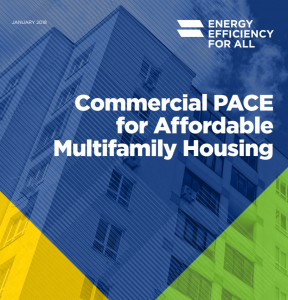
Energy efficiency improvements in affordable multifamily housing reduces energy burdens for residents and helps preserve this important housing stock. The Commercial PACE for Affordable Multifamily Housing study shows that there are instances where C-PACE could help unlock additional energy savings in multifamily properties. Benefits of C-PACE should not just be enjoyed by the commercial and industrial sectors; there is a lot of potential for C-PACE to benefit the multifamily sector.
Click here to read the entire report.
VAEEC’s C-PACE Efforts
The VAEEC is committed to accelerating the implementation and utilization of C-PACE throughout the Commonwealth. Along with our PACE technical consultant, Abacus Property Solutions, the VAEEC has been intimately involved in C-PACE education and outreach with stakeholders, including localities, property owners and developers, contractors, and lenders, to build a coalition of supporters and to encourage localities to move forward with developing C-PACE programs. Additionally, we have been working with stakeholders to develop a model ordinance and with our Mid-Atlantic PACE Alliance, or MAPA, partners to develop regional guidelines to accelerate the implementation of successful C-PACE programs throughout the Commonwealth and Mid-Atlantic region.
This study found that the high cost of C-PACE financing compared to the low cost of capital through federal or state backed housing loans is a barrier. However, in speaking with the Virginia Housing and Development Authority (VHDA) and other LIHTC experts in the Commonwealth, these low cost loans have specific restrictions that limit the ability to go beyond the standard needs of a building. In this instance, C-PACE can provide financing for measures that cannot be underwritten by HUD or VHDA, such as solar photovoltaics.
Additionally, the study briefly mentions the interaction of C-PACE on new construction and the challenges it can entail. The VAEEC has begun reaching out and working with stakeholders across the country who have experience using C-PACE with new construction to compile a list of best practices and lessons learned. This includes a list of projects that should qualify for C-PACE financing, how to determine the Savings to Investment ratio (SIR), and how to determine what percentage of the construction costs are eligible for C-PACE financing. We will continue this outreach in an effort to provide guidance to stakeholders hoping to use C-PACE on new construction in Virginia and the Mid-Atlantic region.
The VAEEC agrees with the study’s findings about the potential of C-PACE within the multifamily sector. In fact, this is a sector that we intend to focus on more in 2018. We will be working with our members, partners, and stakeholders to increase the awareness and knowledge of C-PACE within the multifamily sector.
To learn more about the basics of C-PACE, view the VAEEC PACE webpage, factsheet, or PACE video.
Yesterday, the Virginia Energy Efficiency Council attended Governor-elect Ralph Northam’s Policy Council on Commerce and Trade in Richmond.
The VAEEC’s main asks of the incoming administration are included in this one-pager, which summarizes the report we released earlier this year, Why Energy Efficiency is a Smart Investment for Virginia.


On November 29, 2017, the Virginia Energy Efficiency Council held our latest Commercial Property Assessed Clean Energy, or PACE, Lunch + Learn for Fairfax County and surrounding areas. With an audience of approximately 70 contractors, developers, property owners, lenders, and government officials, this was our largest PACE Lunch + Learn event to-date. The Great Falls Group of the Virginia Sierra Club co-hosted the event, and sponsors included Petros PACE Finance (event sponsor) and John Marshall Bank- Tysons Corner Region (lunch and networking sponsor).
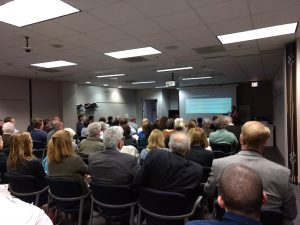 The following speakers provided attendees with an overview of Commercial PACE, including its status across the Commonwealth, case studies, and its value proposition for the area, as well as the development and status of Arlington County’s PACE program:
The following speakers provided attendees with an overview of Commercial PACE, including its status across the Commonwealth, case studies, and its value proposition for the area, as well as the development and status of Arlington County’s PACE program:
- Abigail Johnson, President, Abacus Property Solutions and Atlantic PACE
- Cliff Kellogg, Vice President of Strategic Initiatives, Petros PACE Finance
- Richard Dooley, Community Energy Coordinator, Arlington County
The timing of this event allowed speakers to update guests on the recent PACE advances in the Commonwealth:
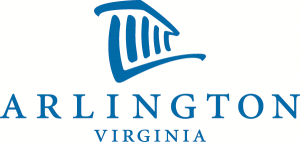 On November 18th, the Arlington County Board approved the County’s PACE ordinance, thus making Arlington the first locality in Virginia to offer a PACE program. Sustainable Real Estate Solutions, or SRS, will serve as the County’s program administrator in charge of outreach and education, project underwriting, and quality assurance. The program is expected to launch this month, and the County is holding a PACE training for contractors on December 12th.
On November 18th, the Arlington County Board approved the County’s PACE ordinance, thus making Arlington the first locality in Virginia to offer a PACE program. Sustainable Real Estate Solutions, or SRS, will serve as the County’s program administrator in charge of outreach and education, project underwriting, and quality assurance. The program is expected to launch this month, and the County is holding a PACE training for contractors on December 12th.
In October, Loudoun County’s Finance Committee forwarded a resolution to adopt a PACE program to the full Board for discussion. The Board will be reviewing this resolution at their January 18th meeting.
- Virginia Model Ordinance and Regional Guidelines will become available in January 2018.
The VAEEC is working with our partners to create a PACE model ordinance, which will help jurisdictions looking to develop their own PACE program. The ordinance will define the roles of all key parties (program administrator, jurisdiction, property owner, and lender), list qualifying improvements, specify how PACE works, and provide a cooperative procurement rider.
 As a part of the Mid-Atlantic PACE Alliance, or MAPA, the VAEEC is working with partners across Virginia, Maryland, and DC to develop regional PACE program guidelines. These guidelines will include: project eligibility standards; the process for a typical PACE project; a suite of template documents; and application requirements. The guidelines will help provide consistency of design, administration, and documents within the Mid-Atlantic region while encouraging standardization and transparency.
As a part of the Mid-Atlantic PACE Alliance, or MAPA, the VAEEC is working with partners across Virginia, Maryland, and DC to develop regional PACE program guidelines. These guidelines will include: project eligibility standards; the process for a typical PACE project; a suite of template documents; and application requirements. The guidelines will help provide consistency of design, administration, and documents within the Mid-Atlantic region while encouraging standardization and transparency.
The Fairfax County Lunch + Learn Presentation and C-PACE Resources document are available to view and download. Visit the VAEEC’s PACE webpage or contact Jessica Greene (jessica@vaeec.org) to learn more about PACE and its status in Virginia.
It’s been a while since our last blog post on the building codes update process and a lot has happened since then. In April, VAEEC and several of our members, participated in an energy stakeholder group to reach consensus with the homebuilders and code officials to incorporate some energy efficiency measures in the new draft Uniform Statewide Building Code (USBC).
These new energy efficiency requirements include removing the visual inspection for duct-testing and bringing duct-testing standards up to the current 2015 model code standard. According to a Department of Energy report, requiring mechanical testing for both air-duct tightness and building envelope tightness are significant opportunities for Virginia. According to the EPA, leaky ducts can reduce the performance efficiency of heating and cooling units by 20%. We are very pleased to see the inclusion of mechanical testing for duct leakage in the new USBC.
 A second component of the energy subgroup compromise proposal, includes adoption of the 2018 model code Energy Rating Index (ERI) compliance option rather than the 2015 version. This newer version gives homebuilders greater flexibility and trade-off options, which is important since homebuilders in states that have already adopted the 2015 model code, have been slow to use this pathway. By implementing the 2018 version, Virginia is making the ERI pathway more enticing, which will hopefully result in greater participation.
A second component of the energy subgroup compromise proposal, includes adoption of the 2018 model code Energy Rating Index (ERI) compliance option rather than the 2015 version. This newer version gives homebuilders greater flexibility and trade-off options, which is important since homebuilders in states that have already adopted the 2015 model code, have been slow to use this pathway. By implementing the 2018 version, Virginia is making the ERI pathway more enticing, which will hopefully result in greater participation.
The compromise proposal unanimously passed the Codes and Standards Committee of the Board of Housing and Community Development last month. This new proposal will be part of the new draft USBC that will be reviewed by the full board on October 16, 2017.
You can read more about our support for these proposals in our letter to the Department of Housing and Community Development (DHCD) during the public comment period earlier this year.
These new components are in addition to the energy efficiency measures that are already included in the draft USBC, which was published last December in the Virginia Register. These proposals include improvements on lighting requirements, hot water pipe insulation, and the creation of the 2015 ERI compliance option.
So where do we go from here?
According to the DHCD website, the timeline below lists the next steps to finalizing the new regulations:
- October 16, 2017: DHCD Board will review and vote on final USBC; final draft will be sent to the Governor’s office for review
- Late Fall 2017: Governor’s office and Office of the Attorney General review final draft
- December 2017/ January 2018: Final regulations printed in Virginia Register and 30 day comment period
- February/March 2018: New regulations take effect
Even though we have made good strides in advancing energy efficiency through the building codes, there is still more work to be done. VAEEC will continue to advocate for more efficient window and insulation requirements in future USBC updates, as well as mandating mechanical testing for building envelope air-tightness. Proper air-tightness helps consumers save money on their energy bills while maintaining a consistent comfort level throughout the home by reducing the potential for air leakage to the outside.
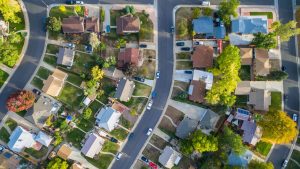 VAEEC partnered with one of our members, Responsible Energy Codes Alliance, to submit a proposal to DHCD staff to host a stakeholder group to review these issues next year, in the hopes that a compromise can be reached on inclusion of this crucial energy efficiency practice in the next USBC update. Last month, we were pleased to see the full DHCD board unanimously vote to support these efforts.
VAEEC partnered with one of our members, Responsible Energy Codes Alliance, to submit a proposal to DHCD staff to host a stakeholder group to review these issues next year, in the hopes that a compromise can be reached on inclusion of this crucial energy efficiency practice in the next USBC update. Last month, we were pleased to see the full DHCD board unanimously vote to support these efforts.
This workgroup will review the results from the DOE Field Study being conducted by VAEEC members Viridiant and the Southeast Energy Efficiency Alliance (SEEA) who will be collecting data in the field to determine what, if any, compliance issues could be addressed through training and education. You can read more about this study on SEEA’s website. The results of this study will greatly inform the workgroup’s ongoing discussions on the need to require mechanical testing for whole-home air tightness. The VAEEC is also working with other members to potentially host a training for the stakeholder group to demonstrate the tests themselves and how the results are interpreted.
You can read more about our recommendations for future building code updates here.
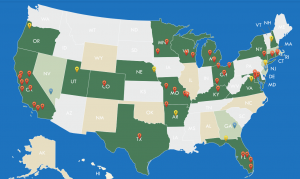


 During the APCO proceeding however,
During the APCO proceeding however, 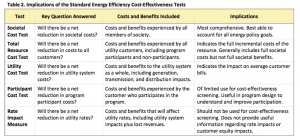


 The Virginia Energy Efficiency Council is excited to announce a new member benefit: the VAEEC Membership Directory. This member-only tool is password protected and hosted on the VAEEC website.
The Virginia Energy Efficiency Council is excited to announce a new member benefit: the VAEEC Membership Directory. This member-only tool is password protected and hosted on the VAEEC website.



 The following speakers provided attendees with an overview of Commercial PACE, including its status across the Commonwealth, case studies, and its value proposition for the area, as well as the development and status of Arlington County’s PACE program:
The following speakers provided attendees with an overview of Commercial PACE, including its status across the Commonwealth, case studies, and its value proposition for the area, as well as the development and status of Arlington County’s PACE program: On November 18th, the Arlington County Board approved the County’s PACE
On November 18th, the Arlington County Board approved the County’s PACE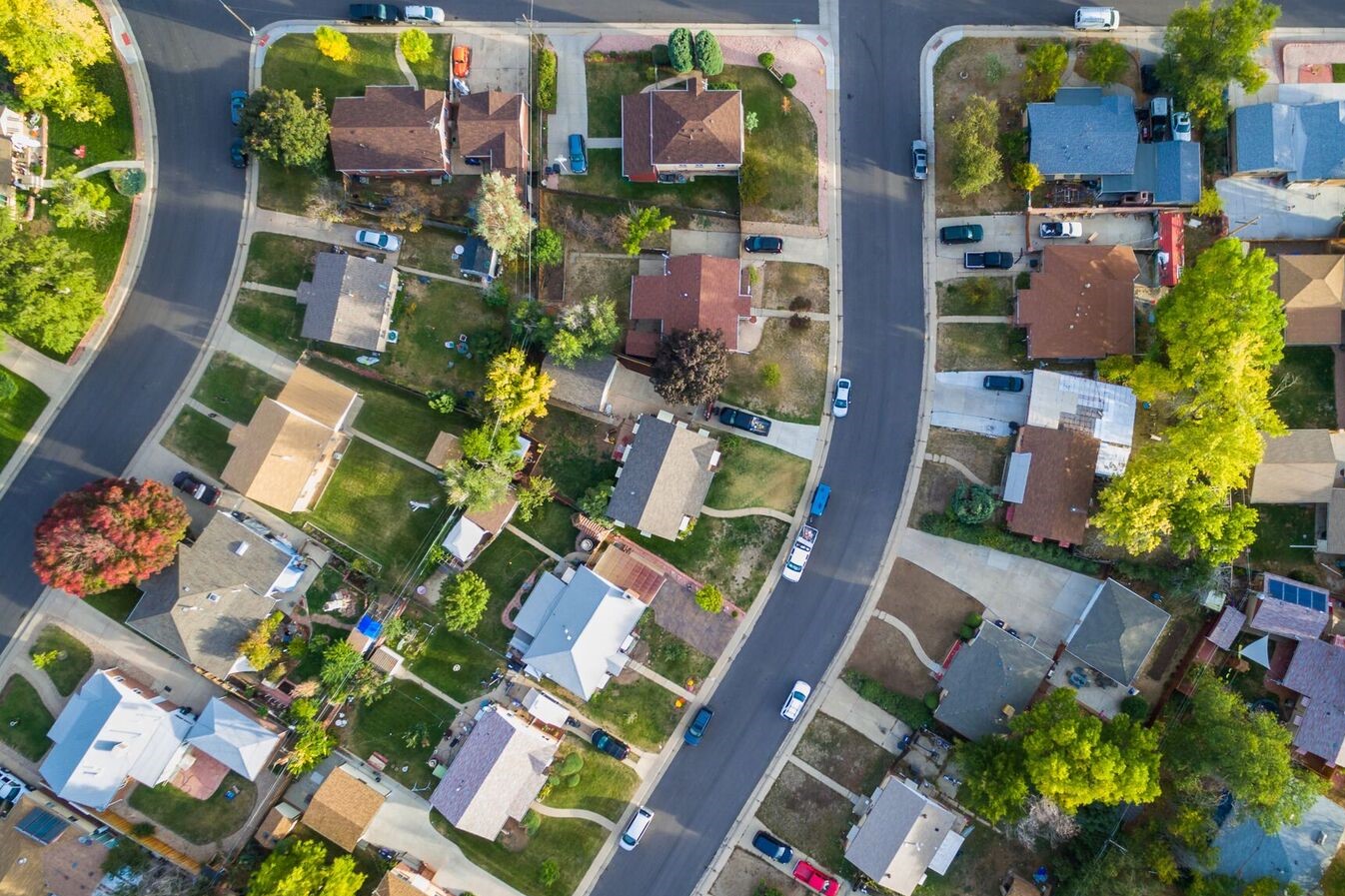
 A second component of the energy subgroup compromise proposal, includes adoption of the 2018 model code Energy Rating Index (ERI) compliance option rather than the 2015 version. This newer version gives homebuilders greater flexibility and trade-off options, which is important since homebuilders in states that have already adopted the 2015 model code, have been slow to use this pathway. By implementing the 2018 version, Virginia is making the ERI pathway more enticing, which will hopefully result in greater participation.
A second component of the energy subgroup compromise proposal, includes adoption of the 2018 model code Energy Rating Index (ERI) compliance option rather than the 2015 version. This newer version gives homebuilders greater flexibility and trade-off options, which is important since homebuilders in states that have already adopted the 2015 model code, have been slow to use this pathway. By implementing the 2018 version, Virginia is making the ERI pathway more enticing, which will hopefully result in greater participation. VAEEC partnered with one of our members, Responsible Energy Codes Alliance, to submit a proposal to DHCD staff to host a stakeholder group to review these issues next year, in the hopes that a compromise can be reached on inclusion of this crucial energy efficiency practice in the next USBC update. Last month, we were pleased to see the full DHCD board unanimously vote to support these efforts.
VAEEC partnered with one of our members, Responsible Energy Codes Alliance, to submit a proposal to DHCD staff to host a stakeholder group to review these issues next year, in the hopes that a compromise can be reached on inclusion of this crucial energy efficiency practice in the next USBC update. Last month, we were pleased to see the full DHCD board unanimously vote to support these efforts.